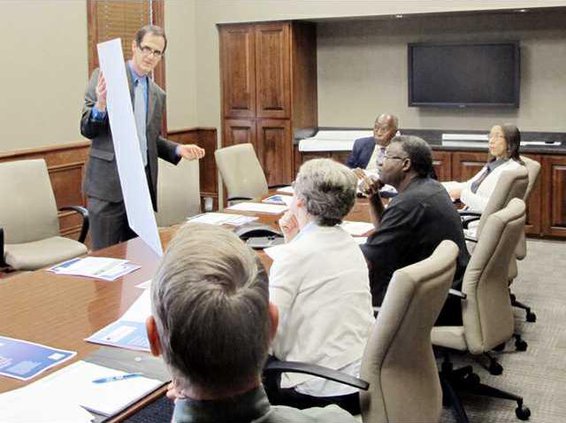Liberty Consolidated Planning Commission Director Jeff Ricketson led the second of two scheduled workshops this week at city hall on the Veterans Parkway Overlay District Study with Hinesville City Council members and Mayor Jim Thomas.
Ricketson said the LCPC would unveil its master plan at the next public workshop scheduled for Oct. 29. Depending on public reaction to the master plan, he said the LCPC would submit its final, revised draft for adoption by the city council Nov. 21.
He started the discussion by reviewing concerns expressed during previous council and public workshops, then he briefly explained the LCPC’s seven guiding principles for the overlay district study.
He quickly went onto land-use designations for the proposed master plan. These designations were color-coded on a map of the district with single-family residential in yellow, medium-density residential in peach, commercial-activity center in red and neighborhood-activity center in dark blue.
Almost immediately, Mayor Pro Tem Charles Frasier raised concerns about the commercial-activity center area between E.G. Miles and South Main Street, which is bordered by Veterans Parkway on the north. He said he did not realize the commercial lines would extend that far for that particular area. Thomas also pointed out that particular area has had sewage problems in the past.
“That’s something we’ll have to address (as part of the development),” Thomas said. “I think we’re going to have to have an additional pumping station there.”
Ricketson noted the leaders’ concerns and said the LCPC would amend maps for the commercial-activity center between E.G. Miles Parkway and South Main Street — possibly all the way to Walmart. He advised city leaders to go out and look at the area, then give him their feedback.
He also talked about the neighborhood-activity center, which is near the access point at Fort Stewart. He called it a “small, low-impact, limited-activity” area intended to serve the needs of the immediate adjacent neighborhoods. He said development here would have to accommodate pedestrian traffic and would not generate noxious fumes, excessive light or noise.
Typical commercial development in this area might be convenience stores, specialty-food sales, single-family attached dwellings, general offices or medical offices, he said.
Ricketson guided the discussion onto the next part of the study, the appearance of the Veterans Parkway corridor. Discussion focused on streetscape themes that determine the “sense of place;” building appearances that restrict at least 50 percent of a building’s exterior walls to brick, stucco or stone; and parking that should be at least visually buffered from the parkway.
Councilman Jason Floyd asked if existing businesses will be grandfathered and not required to reconstruct their parking areas to the new standard. Ricketson said existing business should not be subject to the new changes in the master plan.
Other appearance issues were buffers, which includes retention ponds; neighborhood protection, which includes lighting and law-enforcement patrols; a design-review board; commercial and residential subdivisions; and hardships and variances.
The overlay study also included transportation and recreation, with transportation generating the most comments. There were concerns about “right-in” and “right-out” access roads along the corridor and the need for a traffic light at Walmart’s side entrance that is directly across from the Lowe’s side entrance.
Ricketson reminded the council and mayor that the city is going to have a lot of traffic on Veterans Parkway and said development planning has to ensure that traffic doesn’t interfere with residential areas.
“I think we’re on the right path,” Thomas said as they concluded the workshop. “I think some of the resistance we heard at the first public meeting was from people who just didn’t understand what’s going on.”
Veterans Parkway plan to be unveiled Oct. 29


Sign up for our e-newsletters